Web scraping can be ethical or unethical. Learn how to do it properly and understand its legal implications for your business in this complete guide.
An IP address is an identification number that is assigned to a device connected to the Internet.
Mailbox providers check the reputation of IP addresses that send email on behalf of your domains when deciding whether or not to place your email in the inbox.
There are 2 types of IP addresses that marketers are interested in:
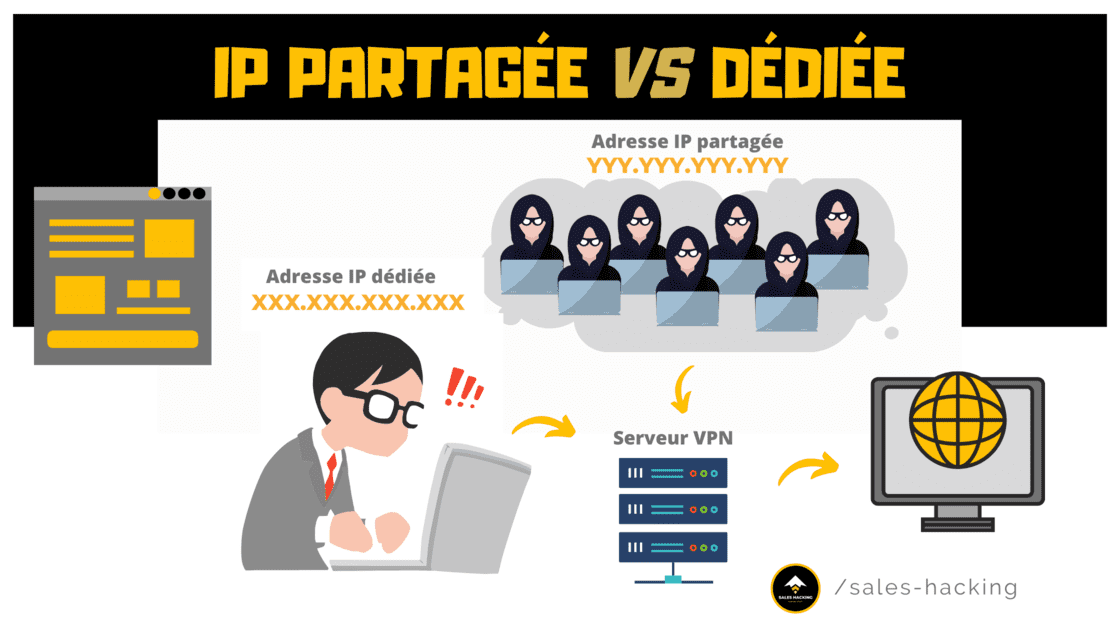
According to best practices, senders should use a dedicated IP address in order to maintain total control over the quality of emails sent via this IP address.
You can't escape a bad reputation by changing your IP address.
Make the appropriate changes to your device to improve your reputation, otherwise the problems will reappear on the new IP address.
Sending from multiple IP addresses isn't always the best choice.
Spammers tend to exploit a large number of IP addresses, switching from one to the other to play with the system. This technique puts you at risk of being put on a blacklisted list.
It is important to start slowly with a low sending volume in order to establish a good reputation for your IP address.
You can then increase the sending volume over time.
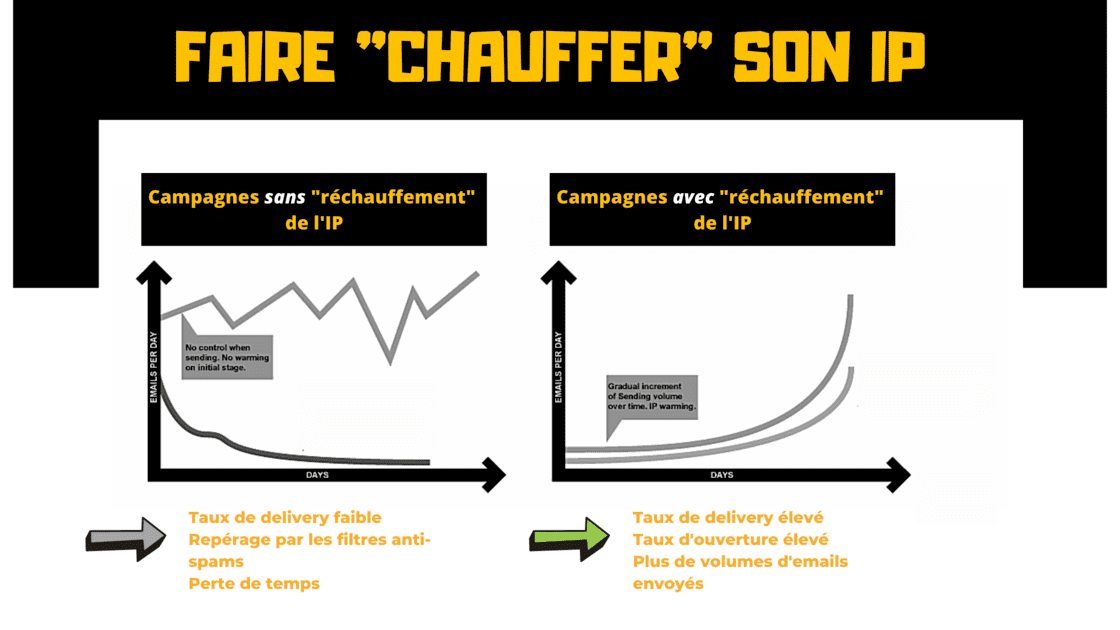
Maintain a constant volume of shipments
Email providers tend to filter mail when significant volume spikes are observed. Once an IP address has acquired a positive reputation, efforts should be made to maintain consistent volume levels. Shippers with inconsistent shipment volumes (for example, seasonal businesses) will need to implement additional strategies to ensure that shipments are ongoing.
A domain name is the name displayed and registered on the Internet (for example, societeabc.com). The reputation of a domain name is equal to that of the domain but also to all subdomains. It is generally linked directly to the signature used in the DKIM authentication protocol.
Here are some metrics to check in order to improve your chances of landing in the inbox and to preserve the quality of your domain name:
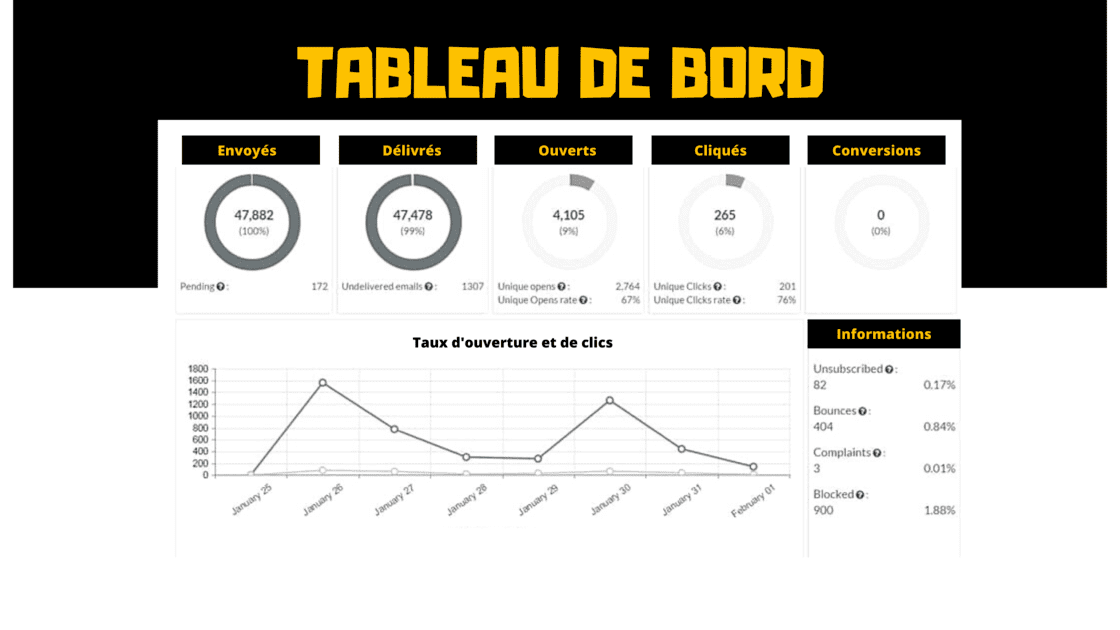
How many times did mail from this domain go to the “spam” folder due to the reputation of the IP address or the filters applied?
How many times has a recipient reported a message from this domain as spam?
How many times has mail from this domain arrived in the inbox?
How many times has a recipient gone to their spam folder and marked a message from that domain as “not spam”?
We will take a closer look at these measures in the following chapters.
You can't build a great email engine on fragile foundations. You need a solid foundation (or “infrastructure”) that includes accurate authentication, bounce management, and response loop processing if you want to build a world-class email system.
Authentication technology allows the email recipient and the mailbox provider to confirm the identity of the sender. If the sender's identity cannot be authenticated, mailbox providers can reject the message or subject it to additional filters to determine if it should be delivered.
Without authentication, your chances of being filtered or blocked by major email providers are increased. As a legitimate business, authentication isn't optional; it's critical to protecting your brand and online reputation. There are three main authentication methods:
Domain-based Message Authentication, Reporting, & Conformance (DMARC) ensures that legitimate email is properly authenticated against established DKIM and SPF standards, and that fraudulent activity that appears to come from legitimate domains is blocked.
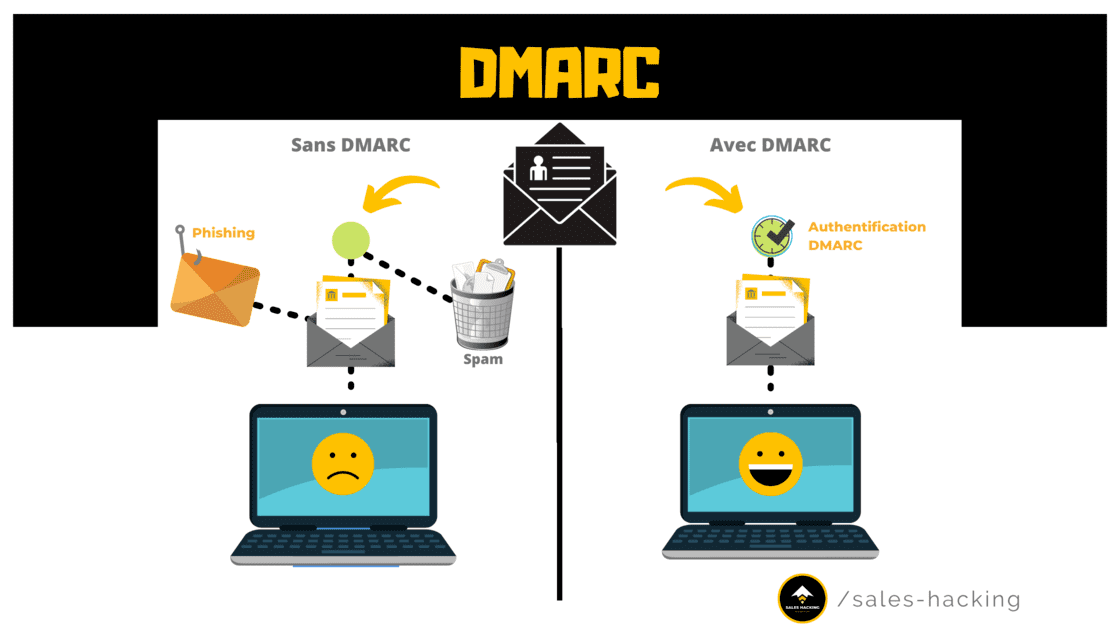
DKIM (DomainKeys Identified Mail) provides a method for validating the domain name from which you are sending your messages using encrypted authentication that is accessible to the general public. It signs each message in a way that is difficult to falsify, proving that the message came from the specified sending domain.

SPF (DomainKeys Identified Mail) is an authentication based on the IP address that validates that a message comes from a mail server (IP address) authorized to send mail for the sending domain. SPF checks are carried out through the information in the header of your message.

Are you using a free webmail email address (Gmail, Yahoo, etc.)?
Unfortunately, it's not possible to set up SPF and DKIM records, as you don't manage these sites. That's why it's always best to use mailing addresses that are linked to your own site.
Ideally, your mailing list should only be populated by email addresses of people who are actively involved in your brand and want to receive your emails. The reality is very different, but it is important to strive for this ideal because the quality of your mailing list can have a considerable impact on your deliverability...
Email providers monitor the addresses you send to and will filter or block your email if poor list quality is noticed. There are several types of data that you need to monitor within your list:
An unknown user is a recipient who never existed, who was terminated by the mailbox provider, or who was abandoned by the end user. Mailbox providers return a return code that indicates that the email is being sent to an unknown user. For example, mailbox providers return a hard return code that indicates that the email is being sent to an unknown user:
The unknown user rate is calculated by dividing the Number of email addresses associated with a 5xx code By the total volume of letters sent. Keep your unknown user usage rate below 2% to get a high placement in your inbox. An unknown user rate greater than 10% will likely lead to deliverability issues.
Spam traps are email addresses that do not belong to active users and are used to identify both spammers and senders with poor practices. Mailbox providers, filtering companies, and blacklist administrators create and manage trap networks to monitor emails received at these addresses.

When a shipper supplier asks for these famous pitfalls, it automatically questions the quality of the shipper list, because the results indicate that the shipper:
They then issue a verdict on the sender's IP address, domain, or content, allowing their email provider partners or filtering companies to take actions such as temporarily (or even permanently) blocking the sender's emails.
Inactive addresses represent customers in your list file who have not opened, clicked, or taken any action for a significant period of time. Many senders have too many inactive addresses in their email listing. For some, this segment can represent up to 70 to 80% of their email file.
Inactive subscribers are unwanted for a number of reasons. Not only can these addresses be a source of unknown users or spam traps, but they also lower the response rate for all campaigns and therefore have a negative impact on your overall reputation.
One of the main goals of mailbox providers is to protect their users. As such, they place great value on the reactions and preferences of their users. If recipients complain about your email, the mailbox providers will perceive your email as junk and block your email in the inbox.
As a result, reports are among the most important factors that contribute to a shipper's poor reputation.
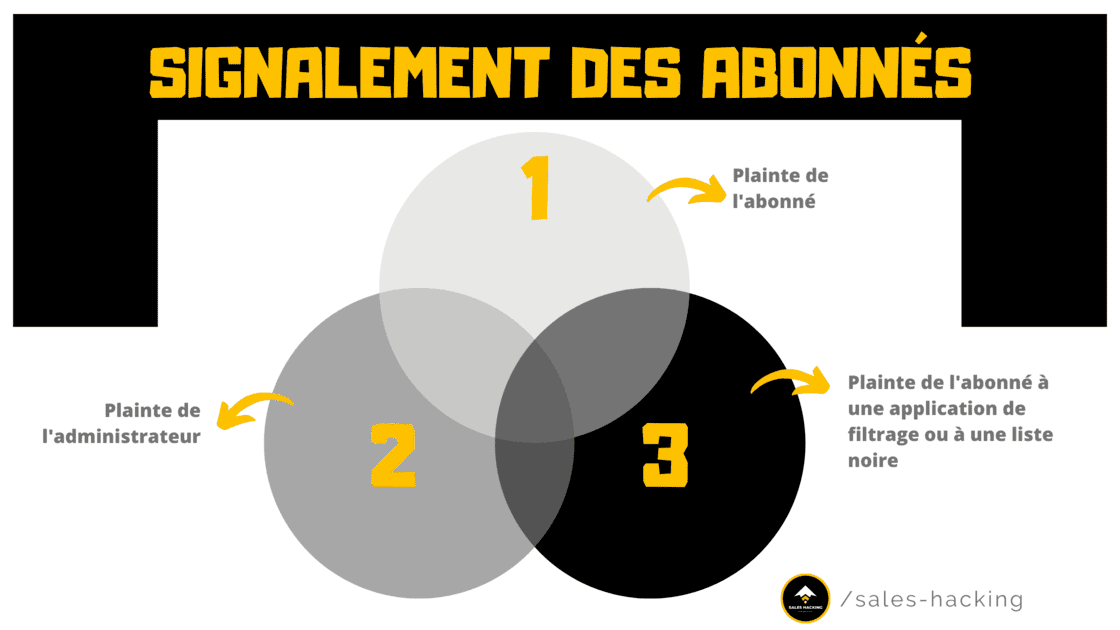
A subscriber can file a complaint in 3 ways:
To best manage your campaigns, set up a process to identify inactive subscribers or use tools to automatically clean your database.
Below are a few tools that effectively take care of this work:
Whether in the title or the content of your emails, some words that are too “flashy” will take you directly to the SPAM box if you are not careful
Below is a quick list of words that won't help you land in your inbox if you're not careful.


As I can point out in this article: if you target the right people with engaging content with the right frequency, you shouldn't have a problem.
Indeed, if your recipients trust your brand, are engaged and interact well with your emails, you will be sure to reach the inbox much more easily.
It is questionable and counterintuitive to add an unsubscribe link when it comes to prospecting emails, but it is an ethical practice and strongly recommended.
What would you say if you received an email from the same sender once a day and didn't have the right to unsubscribe? Most people will tend to report this email as SPAM: a result that we certainly do not want to have in order to maintain the authority of our domain name.

The presence of an unsubscribe link reinforces the trust of your subscribers and also allows you to keep only “engaged” contacts on your list.
In order to assess commitment, it is necessary to manage a set of metrics. That's what we're going to see together right away.
Calculated by dividing the volume of emails delivered by the volume of emails sent. Note: “Delivered” doesn't necessarily mean your email arrived in the inbox, just that it wasn't rejected.
These are emails that are not delivered due to domain name or IP address reputation issues.
The inbox placement rate measures the percentage of emails sent that actually end up in subscribers' inboxes - a much more accurate measure than the delivery rate.
Calculated by dividing the number of emails opened by the number of emails delivered. This measure is actually less useful than you think, because an email won't be considered “open” if it contains only text. It is open if it contains images in the content (this could simply be the logo present in your signature) and if they have been uploaded automately/dynamically or by the user (pressing a button “Download” the images/attachments).
The read rate is similar to the open rate, but it is much more accurate because it takes into account all the emails consulted, regardless of the content of the email (with or without images)
Calculated by dividing the number of clicks by the volume of emails delivered. This measure is commonly used to measure message engagement.
Calculated by dividing the number of spam reports by the number of emails delivered. Reportations are an important indicator of negative engagement and this measure is useful in identifying reports and their sources, but it can be skewed by deliverability issues.
Messages are temporarily rejected, usually due to issues with the recipient's mailbox or server (for example, a mailbox that's too full or an HS server).
Measures how a recipient deletes an email without reading it. This measure allows you to better understand the difference between subscribers who do not want to read your emails and those who only rarely consult them.
Calculated by dividing the number of unsubscriptions by the number of emails delivered.
The most valuable metrics are those of The commitment of your subscribers. The following email metrics provide the content of subscribers' commitment to your brand, as well as the depth of their engagement.
Properly interpreted, parameters can help you measure specific aspects of your email campaigns, such as the effectiveness of the content or the design of your emails.
Measured by calculating the ratio between the total number of clicks and the total number of emails opened. It provides valuable information about the effectiveness of your email content and design.
It measures how often recipients click the “This is not spam” button. This metric is a powerful indicator of subscriber engagement.
Measures how often subscribers forward your email to others. This measure is useful for evaluating the Virality of your content: a high sharing rate indicates a high level of subscriber engagement.
Calculated by dividing the number of conversions by the total number of visits. Although it is an important indicator of subscriber engagement, this measure generally relates more to the quality of content on landing pages or websites than to the quality of email content.
FALSE: The delivery rate is one of the most used metrics in email marketing, but this measure is very misleading and completely misunderstood. The delivery rate doesn't actually measure the number of emails received in the inbox; it just tells you how many of your emails aren't returned or rejected.
REALITY:
Instead of aiming for a 99% delivery rate, aim for higher inbox penetration and ensure that as many emails as possible are delivered and seen by the largest number of subscribers.
Maintain good list quality, meet subscribers' expectations, and send compelling messages at the right time to stand out in the inbox.
Of course, your mailbox provider may be responsible for some delivery issues if the sending infrastructure isn't properly configured, or if they've assigned you a shared IP address that has a bad reputation.
These scenarios are generally the exception, not the rule.
As the sender, you are responsible for the deliverability and reputation of your email. Your reputation is determined by the quality of your lists, reports, message quality, and subscriber engagement. When email providers care about your deliverability, they seek to protect their network, business, and customers by only allowing reputable senders to send from their systems.
Unless you address the root cause of your bad reputation, no mailbox provider can do wonders to make it into inboxes.
The score indicates the reliability of the sender's IP address. It tells email providers how likely their users are to think your email is spam or not.
It's more an indication of the potential of your email than anything else. Ultimately, it's just one of the many settings you need to understand how email providers filter, block, or group your emails instead of putting them in the inbox.
Your Sender Score is not the same as your inbox penetration rate.
Instead, consider that a low sender score has a higher probability that emails sent from your IP address will be classified as SPAM.
SPAM report rates are calculated based on the total number of reports and the total number of messages sent to the inbox.
If your mail goes directly to the spam folder, you may have a low rate, because it is not possible to report an email as SPAM if it is already in the same folder.
If you are present in spam, the rate of “This is not SPAM” should be taken into account. Some filters and mailbox providers go even further and only count reports from active, trusted subscribers, which means that any inactive email addresses on your file that never complain won't be counted in the calculation.
As such, this means that your SPAM report rate is probably much higher than you think from email providers and spam filters.
Reports are a factor, but not the only one, that allows you to understand your ability to deliver emails. As the landscape of email deliverability parameters becomes more complex, you need to know the elements that can have a positive effect on your email penetration rate, such as the “This is not SPAM” rate.
Spam filtering systems rely heavily on the reputation of the sender when it comes to deciding where your email should be placed in the inbox or spam folder.
Content only plays a minor role in filtering decisions for senders today, as spam filters today receive too many false negatives, are not reliable, and are easy for spammers to bypass.
If you're not sure if your content triggers spam filters or not, use a tool like Mailtester to test the main spam filters that will report certain keywords, URLs, or HTML issues in your content.
If you have a good reputation, that doesn't mean you'll pass all spam filters, nor does it mean that the content isn't important.
If you send third-party content or templates used by others, your content could get a bad rap in turn.
Thus, while content can influence delivery, filtering is not necessarily the result of the content itself.
A nice email is good but an email that arrives in the inbox is better isn't it? Some tools allow you to check the junk content of your emails.
Before embarking on major campaigns, it is important to check certain points:
Here is a tool that does this task quite well: Mailtester
There are countless articles on the web called “How to avoid spam filters.”
The problem with most of these articles and their advice is that they are based on the erroneous assumption that spam filters can be avoided.
Spam filters are part of the game. If you send an email, it will be filtered:
Filtering technology plays an important role in the success of your email campaigns. That's why I encourage you to get familiar with spam filters, learn how they work, and understand how email providers use them.
Spam filters examine emails according to specific criteria.
Originally, filters were designed primarily to identify spam messages, block them, or place them in the junk folder.
Today, some providers use them to classify messages for inbox organization purposes (for example: Social Networks, Newsletters, Advertising, etc.).
Vendors have great incentives to use spam filters, for this they develop their own system or use third-party filtering technologies (or a combination of both).
Spam may be annoying, but above all, it can be dangerous.
Malware and phishing are extremely profitable for scammers and can be expensive for email provider customers but also for themselves.
Concretely, anti-spam filters significantly reduce the load on server resources. To date, 70% of all messages sent in the world are spam, which lets you imagine the importance of creating effective filters.
Spam filtering technology can be placed on both inbound and outbound emailing.
Mailbox providers use both methods to protect their customers.
Both inbound and outbound filtering methods use algorithms that tell a program what to do. This system works by submitting emails to thousands of predefined rules (algorithms).
Each rule assigns a numerical score to the probability that the message is spam.
One of the best known and most used detection techniques to date is called Bayesian filtering: for those who would like to delve into the mathematical model of this filter, I provide a link to a very well done article on Wikipedia: Bayesian filter
Mailbox providers consider three main aspects of email messages when making filtering decisions: